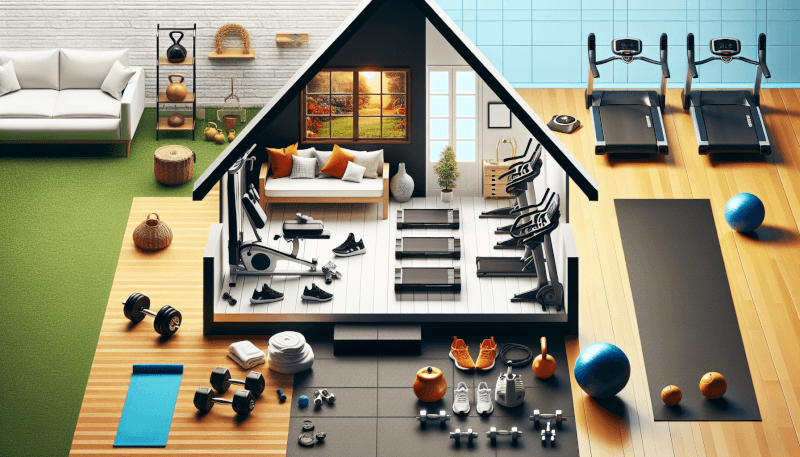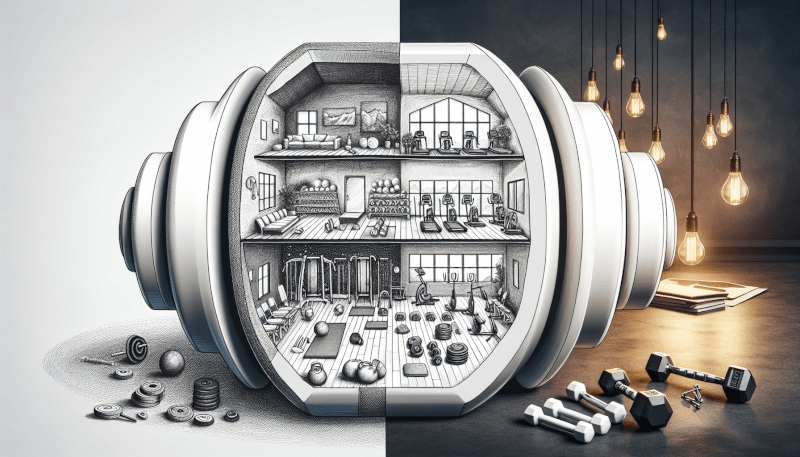Are you torn between creating your own home gym or joining a commercial gym? The age-old debate of DIY home gyms versus commercial gyms continues to divide fitness enthusiasts. Each option offers unique advantages and considerations. In this article, we will explore the pros and cons of both choices, helping you make an informed decision that suits your fitness goals, preferences, and budget. Whether you want the convenience of exercising at home or crave the variety and social atmosphere of a commercial gym, we’ve got you covered. So, let’s dive right in and find out which option is better for you!

Cost
Initial cost
When it comes to cost, setting up a home gym can be a more affordable option compared to joining a commercial gym. You have the flexibility to choose the equipment and accessories that fit your budget and needs. While the initial investment might seem higher, considering the pricing of quality equipment, over time, it can turn out to be cost-effective. Additionally, you can find great deals on used equipment, further reducing the initial cost of setting up your DIY home gym.
Monthly expenses
In terms of monthly expenses, a DIY home gym has a clear advantage. Once you have invested in the necessary equipment, there are no recurring membership fees. This means that you can save a significant amount of money by eliminating the cost of a commercial gym membership. However, it’s important to factor in the cost of utilities and maintenance of your home gym equipment, as these will contribute to your monthly expenses.
Convenience
Accessibility
One of the major perks of having a DIY home gym is the accessibility it offers. You have the convenience of accessing your gym on your own terms, without worrying about operating hours or commuting time. With a home gym, you can work out whenever it fits your schedule, whether it’s early in the morning or late at night. The ease of accessibility allows you to eliminate any excuses and prioritize your fitness goals without any external limitations.
Operating hours
Commercial gyms typically have set operating hours, which may not always align with your busy schedule. This can be a hassle, especially for those who have irregular work hours or obligations that require flexibility. On the other hand, a home gym eliminates the need to adjust your routine to accommodate a commercial gym’s operating hours. Whether you prefer a workout before sunrise or late in the evening, your DIY home gym is always open and ready for you.
Equipment
Variety
Commercial gyms are known for their vast range of equipment options, which can be a significant advantage for those looking to try out different machines and tools. However, with a bit of research and planning, you can achieve a good variety of equipment in your DIY home gym as well. Prioritize the equipment that aligns with your fitness goals and choose versatile pieces that offer a wide range of exercises to maximize your workout routines.
Quality
When it comes to the quality of equipment, commercial gyms often invest in high-end, professional-grade machines and tools. However, this doesn’t mean that you can’t have quality equipment in your home gym. By carefully selecting reputable brands and investing in durable equipment, you can ensure that your DIY home gym offers the same level of quality and functionality. Make sure to read reviews, compare prices, and choose equipment that suits your budget and fitness requirements.
Space
Size
The available space for your gym is a crucial aspect to consider. While commercial gyms usually have spacious layouts with a wide variety of workout areas, your DIY home gym might be limited by the size of your home or designated workout space. However, don’t let that discourage you from creating an effective workout area. Compact and foldable equipment options can help you maximize your space, and creative use of your surroundings can add variety to your workouts.
Flexibility
One of the benefits of a DIY home gym is the flexibility it provides in terms of designing and customizing your workout space. You can arrange your equipment and accessories in a way that best suits your preferences and workout routines. Additionally, if you need to adjust or expand your workout area in the future, you have the freedom to do so without any limitations. This flexibility allows you to create an environment that is tailored specifically to your fitness needs and workout style.

Privacy
Comfort
For many, privacy during workouts is an important factor in choosing a gym. When it comes to a DIY home gym, you have complete control over the level of privacy you desire. You can focus solely on your workout without feeling self-conscious or distracted by others around you. Whether you prefer to exercise in solitude or value a peaceful environment, a home gym provides the ultimate privacy to help you stay focused and comfortable during your workouts.
No judgment
Another advantage of having a DIY home gym is the absence of judgment or scrutiny from others. Many people feel self-conscious or uncomfortable in commercial gyms, especially when starting their fitness journey. With a home gym, there is no need to worry about the judgment of others. You are free to explore new exercises, push your limits, and grow without feeling self-conscious or insecure. The no-judgment environment of a home gym can be a significant boost to your confidence and motivation.
Options for Workout
Classes and trainers
Commercial gyms often offer a variety of classes and access to experienced trainers, which can be a valuable resource for those seeking guidance and motivation. However, don’t underestimate the options available for your DIY home gym. Many fitness professionals and trainers offer online classes or personalized training sessions that can be tailored to your specific needs and goals. By taking advantage of these resources, you can create an effective workout plan and receive expert guidance from the comfort of your home gym.
Personalized workouts
Having a DIY home gym allows you to design and personalize your workouts according to your preferences and goals. You have the freedom to choose your preferred exercises, intensity levels, and workout durations. This flexibility enables you to create a routine that aligns with your specific fitness objectives, whether it’s building strength, improving cardiovascular endurance, or focusing on particular muscle groups. The ability to tailor your workouts to your liking is a significant advantage of a DIY home gym.

Motivation
Social atmosphere
Commercial gyms are known for their vibrant social atmosphere, where you can interact with fellow fitness enthusiasts and find motivation through a sense of community. While a home gym may not provide the same level of social interaction, you can still find ways to stay motivated. Consider joining online fitness communities, participating in virtual challenges, or inviting friends to join you for workout sessions at your home gym. By maintaining a connection with others who share similar interests, you can still experience the motivation and support that comes from a social environment.
Competition
If you thrive in a competitive environment, commercial gyms often offer various opportunities for friendly competition, such as group fitness classes or gym-wide challenges. However, you can introduce competition into your DIY home gym as well. Set personal fitness goals and track your progress over time. Challenge yourself to beat your previous records or invite friends or family members to engage in friendly fitness competitions. By embracing a competitive mindset, you can stay motivated and push yourself to new heights in your home gym.
Hygiene
Maintenance
Hygiene is an essential aspect of any gym, regardless of whether it’s a commercial gym or a DIY home gym. While commercial gyms usually have dedicated staff to handle maintenance and equipment upkeep, the responsibility for maintaining cleanliness and functionality falls on you in a home gym. Regular equipment cleaning, proper storage of accessories, and routine maintenance checks are essential to ensure a hygienic and safe workout environment. With proper care and attention, you can maintain the cleanliness and longevity of your home gym equipment.
Cleanliness
When it comes to cleanliness, commercial gyms may have an advantage with their professional cleaning services and large-scale facilities. However, by establishing a cleaning routine and ensuring proper ventilation in your home gym, you can maintain a clean and healthy environment. Wipe down equipment after each use, regularly clean mats and flooring, and keep the workout area free from clutter. By prioritizing cleanliness and hygiene in your DIY home gym, you can create a space that promotes a safe and enjoyable workout experience.

Expertise
Guidance
Commercial gyms often employ fitness professionals who can provide valuable guidance and support in achieving fitness goals. However, this doesn’t mean you are limited in expertise in a DIY home gym. Explore online resources, follow reputable fitness influencers, or invest in virtual training sessions to access professional guidance. With the right research and dedication, you can find the expertise you need to create effective workout plans, learn proper form, and receive guidance on nutrition and overall wellness.
Safety measures
Safety is crucial in any fitness routine, and commercial gyms typically have safety measures in place, such as emergency response protocols and staff trained in first aid. In a DIY home gym, it is your responsibility to prioritize safety. Familiarize yourself with proper form and techniques for all exercises, use equipment correctly, and have a plan in place for emergencies. Additionally, consider investing in safety equipment like a first aid kit and a spotter when engaging in exercises that require extra precautions. By being proactive about safety, you can create a secure and injury-free workout space at home.
Long-term goals
Investment in equipment
A home gym allows you to make a long-term investment in quality equipment that can serve you for years to come. While the initial cost may be higher, quality equipment is built to withstand consistent use and offers greater durability compared to some commercial gym equipment. By investing in your own equipment, you have the advantage of convenience and control over the maintenance and condition of your workout tools. This long-term investment can lead to significant savings compared to ongoing commercial gym memberships.
Community support
Commercial gyms often have a strong sense of community among their members, promoting motivation and accountability. However, don’t underestimate the power of community support in a DIY home gym setting. Engage with online fitness communities, join virtual workout challenges, or invite friends and family members to share your fitness journey. By surrounding yourself with individuals who support and encourage your goals, you can maintain a sense of community and receive the necessary support to stay focused and motivated in your home gym.
In conclusion, choosing between a DIY home gym and a commercial gym ultimately depends on your personal preferences, budget, and fitness goals. While commercial gyms offer a wide range of equipment and a social atmosphere, a DIY home gym provides convenience, privacy, and the flexibility to tailor your workouts to your liking. Moreover, the cost-effectiveness and long-term investment of a home gym should not be underestimated. With the right planning, research, and dedication, you can create a comprehensive DIY home gym that meets your fitness needs, supports your long-term goals, and empowers you to achieve your desired level of fitness.



